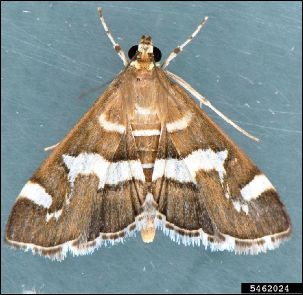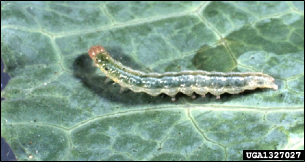Beet Webworm
ID
3104-1542 (ENTO-443NP)
Introduction
Beet webworm, Spoladea recurvalis (F.), is a moth in the family Crambidae in the order Lepidoptera.
Description
The adult moth is chocolate brown with strong white bands across the wings and abdomen (Fig 1). There is a fringe of white and brown hairs on the lower edges of the wings and the body is somewhat triangular in appearance. The legs are light colored with brown bands on the first pair of legs while the antennae are dark. The underside of the body is light colored. The adults have a wingspan of roughly 2 cm (0.8 inch).

The larva is a pale greenish-yellow caterpillar with a distinct dark stripe running down the back and a light brown head capsule (Fig. 2). The body is shiny, smooth-skinned, sparsely haired, and looks somewhat transparent. Larvae measure up to 25 mm (1 inch) long when fully grown.

Life History
Beet webworm has a complete life cycle of egg, larval, pupal, and adult stages. Adult females lay eggs on the underside of leaves on the host plants. An adult female may lay several hundred eggs in her lifetime. Larvae begin feeding on the underside of leaves, leaving clear “windows” in the leaves with the upper leaf tissue intact until it dries and falls out. Later the larvae strip the foliage except for the major leaf veins. Mature larvae pupate in thin cocoons made in leaf folds or plant debris held together with a few strands of silk. Development from egg to adult takes 3-4 weeks. There may be several generations a year in warmer areas of the United States. Depending on location, adults are active typically in late summer and they can fly long distances.
Common Host Plants
Beet webworm feeds on beets, Swiss chard, spinach, and amaranth grown as a cereal. It is sometimes found on weedy plants in the Amaranth family (various pigweeds, lambsquarters, and goosefoot) and on related ornamentals such as cockscomb and loves-lies- bleeding.
Damage
Beet webworm larvae eat the leaves and buds of young plants. Young larvae feed on the underside of leaves, leaving clear “windows” seen from above. Older larvae feed in protective shelters created by rolling and folding leaves, then tying them together with silk. Only the midrib and strong leaves may remain after heavy feeding by larvae. Abundant pulpy, dark green fecal material may be present where larvae are feeding. Damage may be sporadic and not seen every year.
Distribution
Cosmopolitan and found throughout the United States. Beet webworm can be especially troublesome farther west of the Mississippi River.
Cultural Control
Destroy weeds in and around the garden. In particular, pigweed and lambsquarters may serve as alternate hosts for beet webworms. Other weed species may shelter the adult moths.
Clip off webbed leaves on host plants and crush or otherwise destroy the caterpillars or pupae within them.
Organic/Biological Control
Pyrethrin spray or dust can be used, but must be applied when caterpillars are young and before substantial webbing has been produced. Bt (Bacillus thuringiensis) labeled for caterpillars can also be used following the label rates. Bt is more effective in controlling small caterpillars instead of those that are nearly full-grown and not eating as much. The beet webworm's habit of enclosing itself in folded leaves protects it not only from insecticides, but from many natural enemies as well.
Chemical Control
Treat with a registered insecticide effective against caterpillars when insects appear in damaging numbers; repeat as needed. As with all pesticides, follow the label instructions carefully with regards to rates and precautions.
For treatment recommendations in commercial fields or greenhouses, see the current Mid- Atlantic Commercial Vegetable Production Recommendations (VCE Publication 456-420) for products labeled against caterpillars.
Revised
Theresa A. Dellinger, January 15, 2021.
Virginia Cooperative Extension materials are available for public use, reprint, or citation without further permission, provided the use includes credit to the author and to Virginia Cooperative Extension, Virginia Tech, and Virginia State University.
Virginia Cooperative Extension is a partnership of Virginia Tech, Virginia State University, the U.S. Department of Agriculture (USDA), and local governments, and is an equal opportunity employer. For the full non-discrimination statement, please visit ext.vt.edu/accessibility.
Publication Date
March 5, 2021



